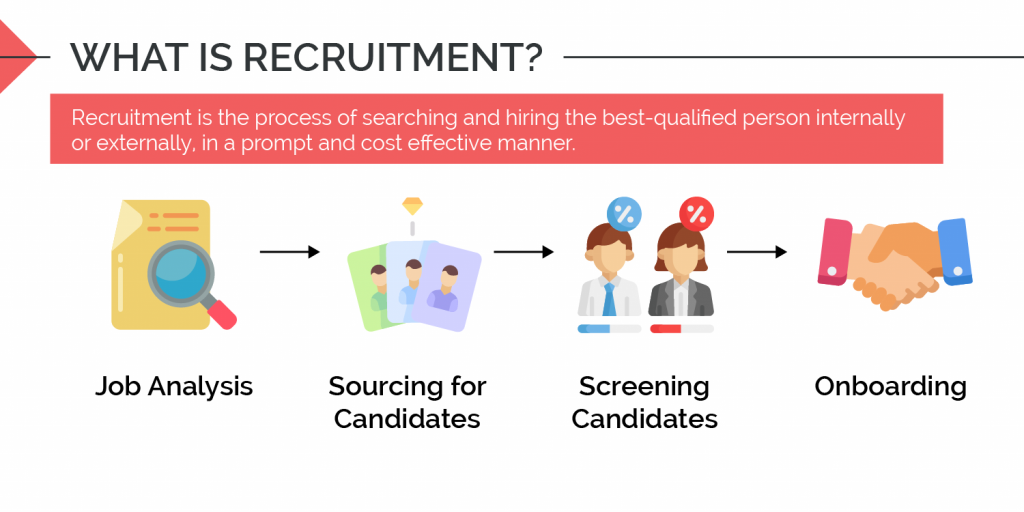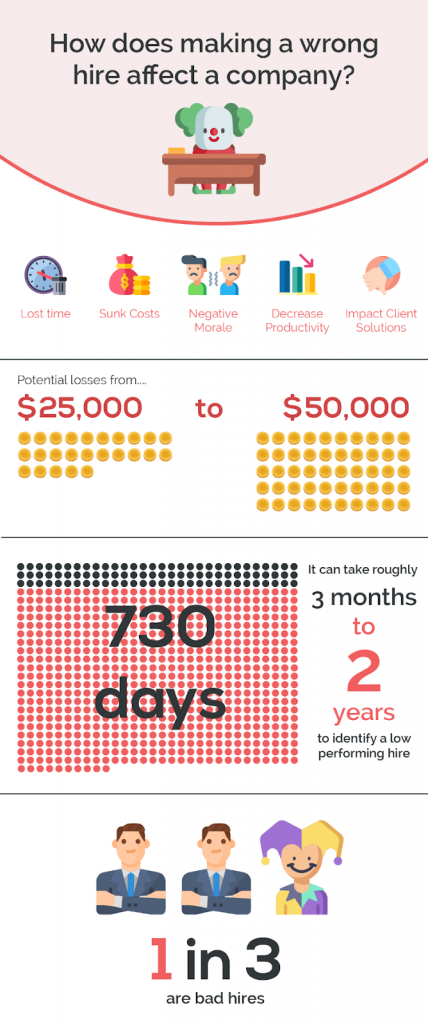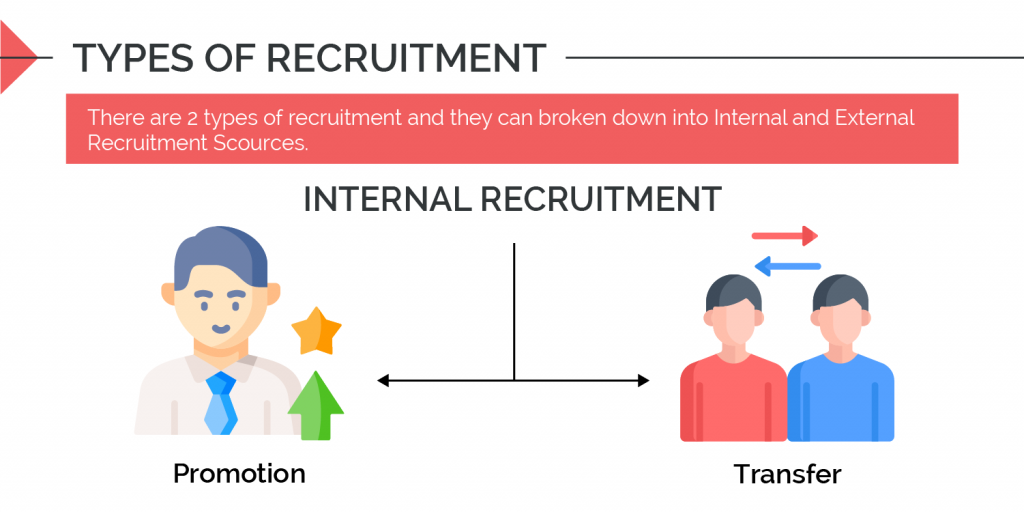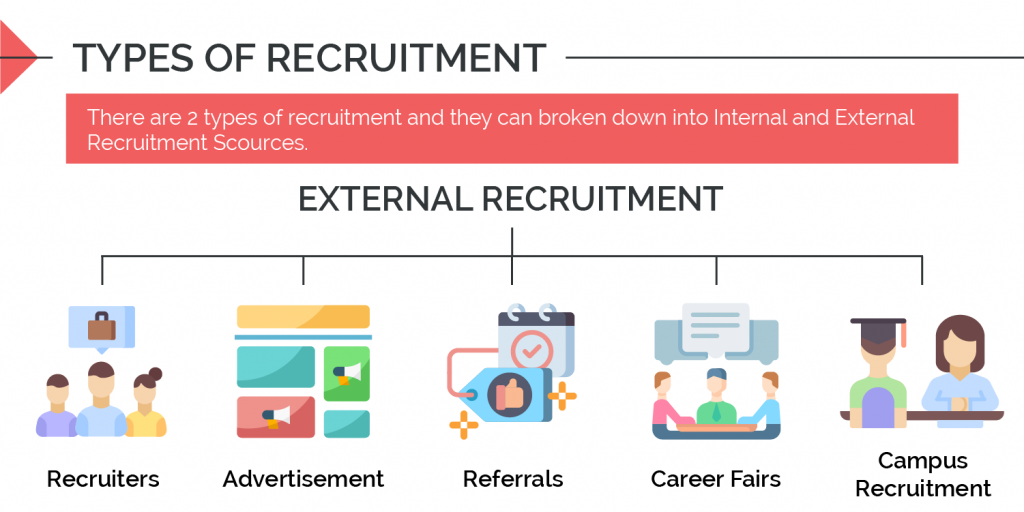The internal structure of an HR department comprises many sub-departments from compensation & benefit, training & development, employee relations, and recruitment. Out of all these, the recruitment department is crucial for its task of finding relevant talents who can perform their duties and are also a great fit in its corporate culture.
There are multiple methods of going about each of these processes and many companies find it such a hassle that they’ve chosen to outsource the entire process to dedicated recruitment companies. However, is that the most effective and cost-efficient method? Is there another way to have more control over our recruitment process, save cost and at the same time, make quality hires?
We will answer these questions as we delve deeper into this article, highlighting pain points on the way and solutions on how to better improve your recruitment process overall.
What is Recruitment?
According to businessdictionary.com, recruitment is the process of searching and hiring the best-qualified person internally or externally, in a prompt and cost-effective manner.

This process usually takes a lot of time and money from analysing the job, finding relevant candidates, screening these candidates and onboarding them. Due to the resources invested in finding relevant candidates, each process is critical in ensuring that a company does not make a bad hire. This pushes HR professionals to find innovative ways to perform each process more efficiently.
Why is Recruitment Important?
To elucidate how important and costly recruitment is, here is an infographic to portray the consequences of a bad hire:


Without good recruitment processes, companies are more inclined to make bad hires. The consequences of a bad hire can be very detrimental to a company in terms of productivity, costs and even morale. According to peoplemattersglobal, it is found that 1 in 3 new employees are bad hires and taking into consideration the fact that it takes 3 months to up to 2 years to identify an unproductive hire. The cost of making a bad hire can range from $25,000 to $50,000 according to a survey by CareerBuilder depending on several factors from the position hired for, time it took to discern a bad hire, cost of finding the candidate etc. To curb these, employers should ensure their recruitment and onboarding processes are up-to-date. This would mean exploring the latest recruitment technology as well as adopting modern practices to ensure that it is parallel to the job seekers of today. Let us look at the processes that go into recruitment as well as the importance of each process.
What are Recruitment Processes?
Analysing the Jobs
HR personnel in the recruitment department have to analyse jobs and understand them before posting them on relevant channels. This ensures that the job posting is shown on relevant channels to get as many relevant applicants as possible. Understanding the function and requirements of a job is an essential first step to ensure the efficiency and effectiveness of the hiring process. A regular job post consists of:
- Job Title
- Job Description (working hours, benefit, responsibilities, requirements, job type)
- Salary
- Location
- Company Hiring
- Company Details (logo, description, media)
Recruitment is like selling job positions to the most relevant and qualified candidate. With so many similar jobs out there, the competition to attract and hire these limited pools of candidates is tough. This forces companies to find creative and innovative ways to attract and appeal to job seekers. Besides just increasing salary, providing more benefits or training opportunities; companies can also utilise tools and features on certain hiring platforms to give their job posting more exposure and engagements.
Searching for candidates
Besides analysing the job in detail, recruiters have to identify the right tools to utilize. For example, depending on the platform used, some platforms offer additional features that give job seekers more information or improves engagement.


For example, Glassdoor provides a platform where current and ex-employees of a company can leave reviews. These reviews give job seekers more information on the work culture of a company and at the same time, it helps companies with multiple positive reviews to appeal better with job seekers.


GrabJobs allows employers to post videos on their company page to better engage with job seekers. The videos give job seekers a peek into the company’s work environment, people and culture. Job seekers can better relate through a video instead of reading a company’s description and history.
Also, some job platforms are catered for specific industries like:


For example, seamanjobsite is a job portal catered for seafarers looking for work on shore. These jobs are usually very niche and are not commonly found on other job portals. Therefore, having such a specific job portal would help greatly in finding relevant candidates.
Recruiters can also leverage on social media to find candidates. With the vast number of active users on platforms like Facebook, Twitter and even messaging apps like Telegram, companies cannot simply ignore the potential of utilising these platforms.
Besides using social media and job platforms alone, recruiters can utilise other channels like Recruiters, Campus Recruitments and even Career Fairs.
Screening Candidates
After receiving applicants, the next step would be to sift through qualified candidates. The screening process for applicants is usually the most time consuming.
Recruiters will usually have to review each applicant’s CV and profile to determine whether this person would be a great fit for the position. However, with technology, there are tools recruiters can use to help alleviate this tedious process.
With CV parsers, ATS systems and even chatbots, leveraging on technology will give recruiters an upper hand by cutting down time and finding the right hires more accurately.
Onboarding Process
The onboarding process is as crucial a step as the rest. A good onboarding process ensures that new hires get to adapt to their environment better as well as for them to understand certain procedures and what is expected of them in their new positions.
A solid onboarding process can assist a new employee to assimilate into their work faster and more effectively after understanding what is expected of them. This also increases the productivity of the entire team to have someone who fits with the company culture.
Types of Recruitment
Recruitment can be broken into two different sources – internal and external.
With Internal Recruitment Sources, companies will tap on their existing employee count and fill an open position by promoting employees or transferring them. Internal Recruitment saves more money and time since there is no need to source for the candidate and there is no need to onboard an existing employee. However, by promoting or transferring an employee from one position to another, it still creates a position left to be filled.


As for External Recruitment Sources, there are many more different channels to explore. The most common would be the use of ads on job portals and even social media. Others may prefer to outsource their recruitment process to companies who specialises in acquiring talent, however, this usually costs more as compared to using job portals. Other channels include referrals and even partnerships with campuses for internship programmes or even hiring full-time fresh graduates.


Recruitment Tools
With the myriad of challenges that comes with recruitment, many companies have invented tools that would help make recruitment more efficient and cost-effective.
Job Portals
Job Portals are one of the most common tools utilised by recruiters. As mentioned previously in the article, there are many kinds of job portals with different niches and uses. Identifying the right platform to use is crucial not only in getting applicants but also in finding relevant candidates.
The niche for these portals can range from specialising in a specific industry to those catering for internship opportunities to a portal only with job postings from startup companies.
Besides identifying the job portal that would be most relevant to the position you are hiring for, recruiters should also identify how to appeal better to job seekers browsing the platform. It is highly likely that the ideal candidate you’re looking for is also being pursued by other companies. Besides paid initiatives like bumping your job to the top of paying for ads, it is the job of recruiters to ensure that their job postings are fully optimised by leveraging on every potential feature that is provided by the job platform. Optimising all these aspects is crucial in ensuring that your job posting is clear and engaging to relevant candidates.
Applicant Tracking System (ATS)
Applicant Tracking System or ATS for short is a tool that companies use to enhance the efficiency of their recruitment process.
The function of an ATS is to scan an applicant’s resume for keywords that are relevant for certain positions and to parse this information into categories for recruiters to refer to easily. The ATS, however, isn’t a 100% accurate – this means that a resume submitted by someone who is relevant to the position may not be recognised on the ATS.
This may be due to multiple factors like:
- The format of the resume may not be ATS friendly
- Insufficient emphasis on certain keywords
- Templates that are not recognised or are not easily parsed by the ATS
- Images that are not parsable by the ATS
The main purpose of using the ATS is the convenience of not having to scan through a myriad of resumes daily but it is still advisable for recruiters to occasionally check the database for resumes that may not have been ATS compatible. Also with knowledge of how an ATS works, certain applicants may abuse this advantage by over optimising their resume to be ATS compatible when not all information included are accurate.
Social Media
It may come as a shock but many recruiters are leveraging on social media to reach out to potential job applicants.
According to research by Oberlo, roughly 3.5 billion people are active on social media; spending an average of up to 3 hours daily engaging on these platforms. With the diversification of features on social media platforms to remain competitive, some have even integrated their own job marketplace.
Take Facebook, for example, the most used social media platform in the world. Research by Times Business in 2012 shows that 84% of job seekers are using Facebook compared to 36% on Linkedin. However, the inverse is true for recruiters as they still prefer using LinkedIn for their recruitment needs with 94% compared to 65% on Facebook.
Facebook also rolled out their jobs marketplace feature sometime in 2017 and since then, it has been performing well because it is free for employers and users to use! Besides the job marketplace, companies have also been engaging with their demographics on Facebook by running ads, setting up their company pages and sharing engaging content with users.
To summarise, recruiters can engage and find potential job seekers by doing the following:
Effective Recruitment in 2024
With technology evolving at such a fast pace, companies have to ensure that they are up to date with the latest trends and technology in all sectors of the business. Recruitment has seen massive changes in the past years from automation to the policies involved in ensuring ethical and socially acceptable hiring practices. Let’s take a look at some of the new trends to adopt in 2024!
Chatbots
Chatbots may not be a recent invention but the versatility of them makes it easy to integrate with multiple services and products. Coupled with machine learning, chatbots can adapt and evolve into specialists – capable of extracting and identifying data, engaging with job seekers and automating the recruitment process. Using GrabJobs as an example, by implementing a pre-screening interview chatbot, employers can pre-screen candidates by asking them relevant questions which will then rank and evaluate applicants based on their answers. This cuts down the time needed to ask repetitive and mundane questions like “Are you a local or PR in Singapore?” or “How many years of experience do you have in this particular role?” Cutting down on the time taken to sieve out irrelevant candidates, HR professionals can then allocate their time more efficiently – in the process increasing productivity.
Artificial Intelligence (A.I.)
Artificial Intelligence, short for A.I, has shifted the way businesses function from front end interaction with users to the back end evaluation of data. The power of A.I is in its ability to adapt and evolve on its own. Many believe that this power may replace many jobs today due to its ability to perform tasks faster and with more precision. One example of implementing Artificial Intelligence in recruitment is Metaview. Most products in the market are usually more focused on evaluating applicants but Metaview’s approach is to evaluate their interviewers. Interviews are recorded and automatically interpreted based on multiple data points like questions asked, length of interviews, times when a candidate was interrupted, etc. The data collected during the interview gives interviewers a better understanding of their performance and at the same time, provides tips on how they can better improve.
Recruitment Metrics
Data is a crucial aspect for all businesses when it comes to decision making, growth, identifying flaws, implementing change and forecasting the future. In recruitment, there are multiple data points that recruiters and hiring managers should start tracking if they have yet to:
- Cost per Hire
- Time to Fill
- Time to Hire
- Recruitment Funnel Performance at Different Stages
- Employee Turnover Rates
- Quality of Hires
With all these data points, recruiters can identify areas in which they lack and decide on measures to implement that could improve their recruitment process – saving time and costs while increasing efficiency.
Character-based hiring
Workplace culture plays a very important role in influencing morale and productivity in a business. Hiring a candidate with the right experience and qualifications is important but recruiters should not dismiss evaluating a potential candidate based on their character as well. Without evaluating a candidate’s character before hiring, a company may be faced with an employee with years of experience but may lack in ambition, integrity, energy, diversity, ethics, and perspective. Skills and qualifications can be learned through experience but character and values cannot be easily thought. This is not to say that a candidate’s character is more important than their ability to perform in their role but recruiters should give equivalent attention and importance to both when hiring a candidate.
Engagement
The traditional method of job applications usually involves a job seeker submitting a CV through a job portal platform or via email. Many job seekers are left hanging after their application because employers do not reply to them. This also happens when job seekers do not inform employers when they’ve accepted a new offer or they aren’t keen on a role which is another main problem in recruitment – interview no shows. With the rise of chatbots and the emphasis on hiring based on character, employers have taken steps to increase engagement between job seekers. Engaging with job seekers also enables employers to better explain roles, culture, and expectations more accurately. It also cuts down the lag time in between emails and messages.
Videos
Videos are also becoming a popular tool employers use to elucidate corporate culture and branding. Employers can better illustrate these by getting employees to speak about their role and the company. Videos are also more interactive as compared to a job seeker reading through a company’s ‘About Us’ profile.
The Future of Recruitment
The idea of recruitment is easy to grasp but when broken down to its individual functions, recruitment requires more than just the fundamental understanding of its concept. Recruiters and hiring professionals are constantly challenged when it comes to finding the ideal candidate for the lowest cost and in the shortest time. This has pushed recruiters and companies to look at the technology they can leverage on to give them a competitive advantage over the other when searching for the ideal talent. Companies and individuals will have to constantly evolve processes to be more efficient when it comes to recruitment.
























